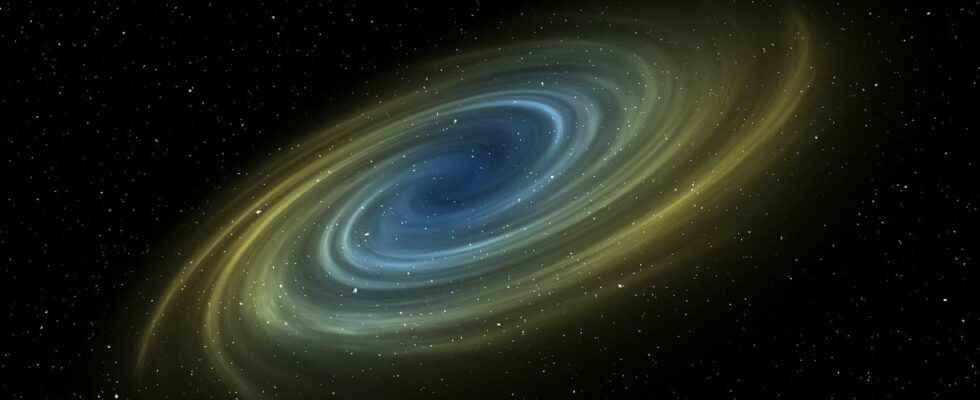the standard cosmological model can boast of many successes. It is based on the existence in the equations ofEinstein of a constant called lambda (Λ) in ancient Greek and which is nothing other than the famous cosmological constant of Einstein. Λ behaves like a density ofenergy and that is why we speak of the existence of thedark energy in the standard model. It is further hypothesized that this energy, which behaves like a pressure repulsive accelerating the expansion of the observable cosmos for a few billion years, does not vary in space and time, even if it becomes more and more dominant with respect to matter because it does not dilute as it would a gas expanding particles.
Now let’s talk about the material content of theUniverse precisely observable. Within the framework of the standard cosmological model, it is dominated by the black matter which is assumed to consist of particles never before seen on Earth in accelerators or detectors, and which cannot interact with standard baryonic matter and with itself solely through the gravitation. This material is also almost essential to account for the characteristics of the cosmic radiation and quite simply the existence of galaxies.
For 13.7 billion years, the Universe has continued to evolve. Contrary to what our eyes tell us when we contemplate the sky, what composes it is far from being static. Physicists have observations at different ages of the Universe and carry out simulations in which they replay its formation and its evolution. It would seem that dark matter has played a big role since the beginning of the Universe until the formation of the large structures observed today. © ECA
However, the standard cosmological model (called ΛCDM with CDM for cold dark matter, that is to say “cold dark matter”) is not perfect and it also leads to paradoxes and apparent contradictions with the experiment which let suspect that, without rejecting it completely, it would undoubtedly be necessary to amend it a little. Thus, the disagreement between the two estimates of the famous constant of the Hubble-Lemaître law concerning the expansion of space has given food for thought to those who think that the Einstein’s constant may not be so constant.
Similarly, problems with the characteristics of dwarf galaxies satellites of large galaxies suggests that there are poorly accounted for interactions between dark matter and ordinary matter, perhaps even between dark matter particles themselves.
An evolving dark matter halo
However, very recently, a team — made up mainly of researchers from the Scuola Internazionale Superiore di Studi Avanzati (Sissa) in Italy, Gauri Sharma, Paolo Salucci and Glenn van de Ven — published the results of their work with an article in the prestigious journal Astronomy and Astrophysics.
The astrophysicists took a closer look at the dark matter content of about 300 large spiral galaxies as the Milky Way and Andromeda, performing a kind of coring time in our past, going back almost 7 billion years ago.
Like their predecessors, such Vera Rubinthey measured the gears from movements from stars and clouds ofhydrogen atomic being able to extend further than the visible edges of these spiral galaxies by means in particular of the famous line at 21 cm. These movements are indicative of the presence and distribution of masses hidden, precisely that of dark matter unless the laws of celestial mechanics are modified within the framework of Mond theory as some researchers have proposed to do.
It then appears that, at the heart of the halos of dark matter enveloping the spiral galaxies, there is a zone of homogeneous overdensity whose size increases over time until it overflows the spiral galaxies themselves.
Everything therefore happens, according to the researchers, as if dark matter had a mysterious additional interaction with normal matter, an interaction forcing the dark matter of the halo to concentrate in such a way as to increase the size of this central core of homogeneous but decreasing density. with time.
At the moment, this does not fit at all with the basic assumptions of the standard cosmological model and it therefore provides new constraints and information on the nature of dark matter whose exact meaning remains to be explored.
Support an editorial team committed to popularizing science on Patreon!
Our mission ? Return the knowledge accessible to everyone.
We produce our own articles, investigations and reports every day, all on a human scale. Support us in this approach and this ambition.
Subscribe to Futura on Patreon!
Two subscription plans are available to you with the following advantages:
- ” Futura ad-free »: get guaranteed ad-free access to the entire site for €3.29/month (+VAT).
- ” I participate in the life of Futura »: in addition to access without advertising, take part in the life of our independent media (votes, new content, surveys, etc.) for €6.29/month (+VAT).
Interested in what you just read?
